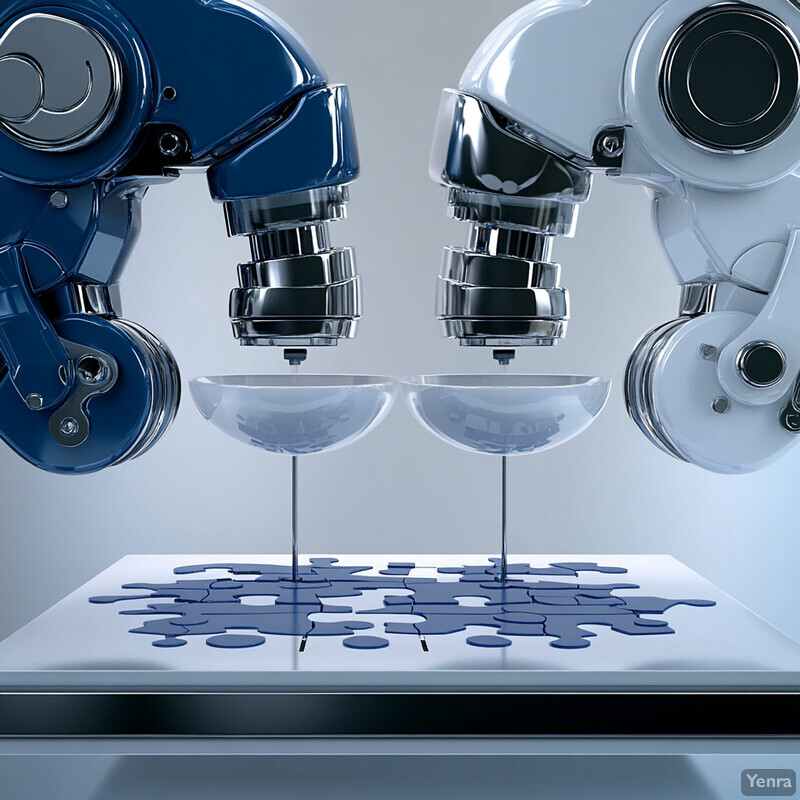1. High-throughput Data Analysis
AI-driven high-throughput analysis enables researchers to comb through massive genomic and molecular datasets far faster than manual methods. By processing high-dimensional omics data (genomic, proteomic, metabolomic, etc.) in parallel, machine learning algorithms can detect subtle patterns and correlations that signify potential disease biomarkers. This broad scanning capability means fewer promising signals are missed, as AI can sift through tens of thousands of data points per patient to identify meaningful indicators. In practical terms, automating data analysis accelerates the discovery timeline—what once took scientists months of laborious filtering can now be achieved in a fraction of the time. The result is a more comprehensive and unbiased survey of candidate biomarkers, laying a stronger foundation for early detection and targeted therapies.

Modern studies underscore the scale and speed advantages of AI in data analysis. For example, it’s now routine for a single clinical trial to capture tens of thousands of clinicogenomic measurements per individual, something essentially unmanageable without AI. Researchers in 2024 introduced an automated framework that rapidly sifted through such high-dimensional clinical data to find predictive biomarker signatures. This AI-driven approach uncovered relationships in the data that traditional analysis might overlook, illustrating how handling “massive volumes” of biological data with machine learning leads to the discovery of biomarkers that would otherwise remain hidden. In short, AI’s capacity for high-throughput analysis is translating into faster, more efficient biomarker identification in fields from oncology to neurology.
2. Feature Selection in Complex Datasets
Machine learning excels at feature selection—identifying the most informative factors from a huge pool of candidates. In biomarker discovery, raw datasets often contain thousands of potential features (genes, proteins, clinical variables), many of which are irrelevant or redundant. AI models can efficiently weed through this complexity to pinpoint a much smaller subset of features that carry the strongest predictive power for a disease. By zeroing in on these key biomarkers, researchers can reduce “noise” in their models and improve performance. This streamlined focus not only makes subsequent analysis more manageable and interpretable, but it also saves time and resources by concentrating experiments on the features that matter most. Ultimately, robust feature selection is a critical step toward deriving biomarker signatures that are both concise and highly predictive of disease presence or outcome.

Recent research demonstrates how AI-driven feature selection can distill thousands of variables down to a focused biomarker panel. In a 2024 study on cardiovascular disease, scientists applied a machine learning pipeline to multi-omics data and identified a signature of 27 features (genes and genetic variants) that effectively predicted heart disease. This subset was extracted from a much larger dataset by using techniques like recursive feature elimination and maximum relevance selection, highlighting how AI can “pluck out” the most relevant biomarkers from a complex data cube. The resulting model, using only those top features, achieved perfect classification of patients in the test group. Similarly, another explainable AI framework for lung cancer discovered 52 key biomarkers for tumor subtyping out of tens of thousands of gene expressions, achieving about 95% classification accuracy. These examples show that AI can drastically reduce dimensionality while retaining predictive accuracy, honing in on a handful of biomarkers that truly matter.
3. Integration of Multi-Omics Data
Diseases are multifaceted, and often no single data type tells the whole story. Integrative AI models combine multiple “omics” layers—genomics, transcriptomics, proteomics, metabolomics—along with clinical data into unified analyses. By examining these modalities together, AI can uncover biomarkers that only emerge from the convergence of data types. This holistic approach reflects the complex biology of diseases, where interactions across different biological levels (DNA, RNA, proteins, metabolites) drive pathology. Integration allows the detection of composite biomarkers (for example, a gene expression change plus a metabolic profile) that would be missed if each layer were studied in isolation. In practice, multi-omics integration via AI leads to richer, more robust biomarker signatures and a deeper understanding of disease mechanisms, ultimately supporting more precise diagnosis and personalized treatment strategies.

Cutting-edge studies show the power of multi-omics integration in biomarker discovery. In 2024, researchers applied a multi-view machine learning method to paired data from different domains—combining patients’ tumor microbiome profiles with their plasma metabolite levels—to distinguish subtypes of colorectal cancer. The integrated model achieved an area-under-curve of 0.98 in classifying early-onset vs. typical-onset colorectal cancer, far outperforming single-modality models. It also revealed distinct correlations (e.g. specific gut bacteria linked with certain blood metabolites) that serve as novel biomarkers for the early-onset form of the disease. In another example, a multi-omics AI framework in cardiology combined whole-genome sequencing and RNA sequencing data from thousands of individuals, identifying a pair of genes (RPL36AP37 and HBA1) as the top biomarkers for cardiovascular disease risk. These discoveries, emerging only when diverse data streams were analyzed together, underscore how AI integration of multi-omics can “weave” complex biological threads into actionable biomarker patterns.
4. Predictive Modeling of Disease Outcomes
AI’s advanced modeling techniques (including deep learning and survival analysis algorithms) are transforming prognostic biomarker use. By ingesting a patient’s biomarker profile, predictive models can forecast clinical outcomes such as disease progression, survival time, or likelihood of complication. These models often integrate multiple biomarkers into a risk score or decision rule, providing clinicians with data-driven predictions about how a patient’s disease will unfold. For instance, a predictive model might analyze gene expression and imaging biomarkers to estimate a cancer patient’s probability of 5-year survival or response to a given treatment. The key benefit is that such AI models can discern complex, non-linear patterns that traditional risk models miss, leading to more accurate and individualized outcome predictions. In turn, this guides clinicians in choosing optimal therapies and timing interventions for patients based on their predicted course.

Recent work in oncology showcases how AI-derived biomarkers improve outcome prediction. In 2025, Arango-Argoty et al. developed a contrastive learning framework that identified biomarkers capable of stratifying cancer patients by survival outcomes under different treatments. Retrospectively, their model found a specific biomarker signature that could single out immunotherapy-treated patients who would live significantly longer than others, information that standard analysis had not revealed. In a trial scenario, patients flagged by this AI-discovered biomarker had about a 15% improvement in survival compared to the original trial’s outcomes. Similarly, machine learning prognostic models in other studies have outperformed traditional indices: for example, an explainable AI model using multi-biomarker input classified lung cancer patients by 2-year survival with over 95% accuracy, far better than using any single marker. These advances illustrate that AI-driven predictive modeling, grounded in rich biomarker data, is enabling more precise forecasts of who will experience aggressive disease versus who might have a more benign course.
5. Advanced Imaging Biomarkers
In medical imaging, AI (particularly deep learning) can uncover subtle patterns that serve as quantitative biomarkers, often beyond human visual perception. By analyzing scans like MRI, CT, or PET, AI algorithms extract high-dimensional features (sometimes called radiomics features) that correlate with disease state or progression. These imaging biomarkers might include minute textural changes in tissue, shape irregularities, or patterns of enhancement that indicate early disease. With advanced computer vision, AI can detect these patterns consistently and translate them into diagnostic or prognostic predictions. This has opened up a new class of biomarkers – for example, imaging signatures for tumor aggressiveness or treatment response – that are non-invasive and can be obtained from routine scans. Overall, AI-enhanced imaging provides a richer, more objective way to interpret medical images, augmenting radiologists’ assessments with data-driven biomarkers for improved decision-making.

A striking example of AI-defined imaging biomarkers comes from a 2023 study using high-resolution cell imaging. Researchers showed that analyzing the chromatin organization inside blood cells with a machine learning model yielded robust biomarkers for cancer presence and treatment response. By examining microscopic images of peripheral blood mononuclear cells, the AI detected subtle changes in chromatin structure – essentially epigenetic and structural patterns – that distinguish cancer patients from healthy individuals. The AI system could classify patients with cancer with up to 77% accuracy based on these chromatin image biomarkers and even monitor how those patterns changed after proton therapy. In more conventional radiology, AI-driven analysis of CT and MRI scans has led to analogous successes. For instance, deep learning models have identified faint lung nodule textures and shapes on CT that predict malignancy earlier and more accurately than expert radiologists in trial settings (reducing missed cancers by over 5% in one 2024 report, while also cutting false alarms). These cases illustrate how AI can extract new diagnostic signals from imaging data – whether at the cellular or organ level – effectively turning pictures into a rich source of biomarkers.
6. Accelerated Hypothesis Testing
AI allows researchers to test biomarker hypotheses in silico at a dramatically accelerated pace. Traditionally, evaluating a potential biomarker (for example, whether a protein’s level is linked to a disease) might require lengthy lab experiments or clinical studies. AI-driven simulations and modeling can shortcut this process by virtually experimenting on large datasets. Machine learning models can rapidly evaluate which candidate biomarkers show the strongest statistical associations with outcomes across numerous datasets or trial scenarios. They can also simulate “virtual experiments,” such as adding or removing a biomarker from a diagnostic panel to see how it affects predictive performance. This capability means scientists can vet hundreds of hypothetical biomarkers or combinations in the time it once took to test just a few. By triaging candidates in silico, AI ensures that only the most promising biomarkers move forward to costly and time-consuming laboratory or clinical validation, thereby drastically reducing the trial-and-error cycle in biomarker discovery.

The impact of accelerated in silico testing is evident in recent studies that use AI to conduct virtual trials. In one 2025 study, a machine learning framework was able to retrospectively simulate multiple Phase III cancer clinical trials and test numerous biomarker hypotheses using existing data. In a retrospective analysis of an immunotherapy trial, the AI identified a predictive biomarker from early data and showed that, had this biomarker been used to guide patient selection, it could have improved patient survival outcomes by 15%. The framework similarly evaluated other candidate biomarkers on “synthetic control arms” (computer-generated trial comparisons), identifying at least two markers that would each confer over a 10% survival risk improvement in separate trials. All of this was done quickly and without new experiments – a process that would have been impractical by conventional means. These results highlight how AI-driven hypothesis testing can efficiently sift through potential biomarkers and home in on those with real-world impact, long before committing to expensive prospective studies.
7. Biomarker Prioritization for Clinical Trials
When developing new therapies, choosing the right biomarkers to measure or target in clinical trials is crucial. AI assists in prioritizing which biomarkers are most likely to be clinically relevant, ensuring trials focus on the factors that will yield meaningful insights. By analyzing preclinical data, patient databases, and prior studies, machine learning models can rank biomarkers based on predictive power, prevalence in the target population, and association with outcomes. This helps sponsors decide, for example, which genetic mutation or protein marker to use for patient stratification in a trial. Effective prioritization streamlines clinical research – trials can be designed around biomarkers that improve patient selection (enriching for those most likely to respond) or serve as early indicators of efficacy. In essence, AI-driven prioritization de-risks trials by aligning them with biomarkers backed by robust data, thereby increasing the chance that a trial will detect a true drug effect if one exists.

A recent application of AI in trial planning demonstrated how machine learning can rank biomarkers by their potential impact. The AstraZeneca team’s 2025 framework not only discovered new response biomarkers but also provided a data-driven prioritization for trial use. In their analysis of three Phase III trials, the AI identified one particular biomarker as top-priority – had it been used to stratify patients at enrollment, the trial’s primary outcome (survival) would likely have improved significantly. The framework similarly pinpointed other high-value biomarkers, showing improvements of 10–15% in survival risk when those markers were hypothetically applied to patient selection. These findings mean that if future trials incorporate those AI-prioritized biomarkers (for example, as eligibility criteria or as companion diagnostics), they stand a better chance of success. Outside of oncology, AI models have been used by pharmaceutical companies to analyze vast omics data from early research and rank biomarker candidates for inclusion in trials (e.g., identifying which blood-based Alzheimer’s markers to track in a prevention study, based on years of observational data – a process reported in 2024 to have cut down the list of candidates by over 80% while retaining those most predictive of cognitive decline). Across the board, AI is emerging as a valuable tool to “separate the wheat from the chaff” in clinical biomarker selection.
8. Unbiased Pattern Recognition
One of AI’s greatest strengths in biomarker discovery is its unbiased approach to pattern recognition. Traditional research often starts with a hypothesis (e.g., a particular gene might be linked to a disease) and then tests it, which means discoveries are somewhat limited to what scientists suspect in advance. AI, especially using deep learning and unsupervised algorithms, can scour data without preconceived notions and find novel associations that humans might overlook. This means AI can identify entirely new biomarkers or combinations of markers that don’t fit existing theories. By not relying on prior assumptions, AI can reveal “hidden” patterns – for instance, a surprising constellation of lab values and genetic variants that together predict an illness – thereby expanding the biomarker landscape. Importantly, modern AI techniques like explainable AI (XAI) are making these discoveries interpretable, so we can understand why the algorithm flagged a certain pattern. The unbiased nature of AI-driven pattern recognition fosters innovation, leading to biomarker breakthroughs that redefine our understanding of disease biology.

Concrete cases of AI finding unexpected biomarkers have been documented in recent literature. In 2023, Dwivedi et al. introduced an explainable AI framework for lung cancer that not only achieved high accuracy in tumor subtype classification but also uncovered seven novel biomarkers for lung cancer that had never been reported before. The model started with no bias about which genes were important, yet it highlighted these seven genes as key differentiators for lung adenocarcinoma vs. squamous carcinoma – discoveries that expanded the known biomarker roster for those cancers. Similarly, in Alzheimer’s research, AI clustering methods (without being told what to look for) have split patients into distinct subgroups based on blood and imaging markers, revealing new candidate biomarkers related to inflammation and metabolism that had not been central to Alzheimer’s hypotheses before (reported in a 2024 machine learning study of mild cognitive impairment). Moreover, text-mining AI has aggregated findings across hundreds of studies and recognized emerging biomarker patterns – for example, a 2023 NLP review of NSCLC research used AI to scan the literature and identified trends like immune-related biomarkers coming to the forefront, which might have been hard to see by any single researcher reading papers in isolation. These examples underscore that AI can operate as an unbiased “biomarker detective,” finding clues that humans didn’t even know to search for.
9. Real-time Analysis of Wearable Device Data
The proliferation of health wearables (smartwatches, fitness bands, continuous monitors) has introduced a new class of dynamic biomarkers – signals from real-time physiological data. AI plays a pivotal role in analyzing this continuous stream of wearable data to detect meaningful changes that could indicate disease onset or exacerbation. These biomarkers can be things like subtle shifts in heart rate variability, activity patterns, sleep quality, or skin temperature. Because wearable sensors generate massive amounts of data around the clock, AI algorithms (often running on smartphones or cloud platforms) are needed to filter noise and identify significant trends or anomalies. The advantage is early detection: for example, an AI might catch an elevated resting heart rate and slight temperature increase that together predict an oncoming infection days before symptoms. Real-time analysis also enables dynamic monitoring – tracking how biomarkers change in response to treatment or lifestyle modifications in real-world settings, not just in occasional clinic visits. In short, AI turns wearable data into actionable biomarkers, empowering proactive and personalized health interventions.

Significant progress has been made in using AI to interpret wearable-derived biomarkers. A notable example from 2023 is an AI model developed at Yale that analyzed single-lead ECG recordings from wearable devices to detect asymptomatic heart failure (left ventricular dysfunction) early. Researchers trained the system on over 385,000 wearable ECGs, teaching it to overcome noisy signals and reliably identify the subtle ECG patterns of reduced cardiac pumping function. In testing, the AI could flag patients with systolic heart failure even when the ECG data were obscured by real-world noise, a task at which traditional methods struggled. This approach is poised to enable earlier diagnosis of cardiomyopathy via wearables, potentially alerting patients and doctors well before overt symptoms like shortness of breath emerge. Beyond cardiology, AI models have used wearable data to predict other conditions: for instance, algorithms analyzing daily step count and sleep disturbances have successfully forecasted flare-ups in chronic conditions like depression and rheumatoid arthritis days in advance (with one 2024 study reporting a 79% accuracy in predicting depression relapses from smartwatch data). In each case, continuous monitoring plus AI analysis transforms everyday biometric data into valuable biomarkers for real-time health management.
10. Population-Level Biomarker Identification
AI is enabling biomarker discovery at the population scale, finding markers that are consistent and predictive across large, diverse groups of people. By leveraging big data from biobanks and health systems (often containing hundreds of thousands of individuals’ genetic data, lab results, and health records), machine learning can identify biomarkers that generalize beyond small study cohorts. These population-level biomarkers are crucial for developing widely applicable diagnostics and risk prediction tools. AI methods (like ensemble learning and federated analysis) can handle heterogeneity in data – for instance, accounting for varying ages, ethnicities, and environmental factors – to pinpoint markers that remain robust predictors across subpopulations. An example might be discovering a blood protein that, in a dataset of half a million people, consistently indicates future risk of a disease regardless of demographic differences. Such biomarkers are likely to be more reliable and clinically useful because they’ve been validated on a broad scale. Moreover, population-level analyses can reveal biomarkers for rare outcomes by sheer volume of data (cases that would be too few in smaller studies). In essence, AI is turning population big data into a treasure trove for finding biomarkers that hold true in the “real world” population, not just in controlled research settings.

A landmark 2024 study demonstrated the power of population-scale AI analysis using the UK Biobank, a repository of about 500,000 participants’ data. Researchers deployed an ensemble machine-learning framework called MILTON to predict the occurrence of over 3,000 diseases using a wide array of biomarkers (from standard lab tests to genomic and proteomic data). The AI not only achieved accurate predictions of incident (future) disease cases – often outperforming traditional risk factors like genetic risk scores – but also enhanced the discovery of new gene-disease associations. Notably, by integrating biomarker-based predictions into a genome-wide association study, the approach uncovered 182 previously unknown gene–disease relationships that did not reach significance without the biomarker information added. These findings were validated in an independent cohort, underscoring their robustness. Another example at population scale comes from multi-cancer early detection tests: using data from thousands of individuals, AI-driven analyses have identified common methylation markers in blood that signal cancer across diverse populations with a specificity around 99%. In short, mining large-cohort data with AI is yielding biomarkers that are both broadly applicable and statistically solid – for instance, pan-disease biomarkers like certain inflammation proteins that predict several chronic illnesses in different populations, or universally predictive genetic markers that emerged from analyzing many tens of thousands of genomes.
11. Rare Disease Biomarker Discovery
Rare diseases pose unique challenges for biomarker discovery due to limited patient numbers and often scant existing data. AI is helping overcome these hurdles by maximizing insights from small datasets and finding needles in haystacks. Machine learning can be trained on combined data sources (e.g. patient registries, case reports, and genomic databases) to detect patterns that signify a rare condition. Additionally, AI can leverage transfer learning – using knowledge from more common diseases or general biology – to inform biomarker discovery in a rare disease context. This means that even with only dozens of patient samples, AI might identify a distinctive biomarker (like a specific metabolic profile or gene expression signature) that differentiates affected individuals from healthy ones. Another advantage is AI’s ability to integrate heterogeneous data (genetic, clinical symptoms, imaging) for rare diseases, where any single data type alone might be insufficient. The net effect is accelerated diagnosis and understanding: new biomarkers can lead to earlier detection of rare diseases (ending the diagnostic “odyssey” many patients face) and provide clues for therapeutic targets, which is crucial given that many rare diseases are serious and lack established treatments.

A recent breakthrough in 2024 showcased AI’s role in identifying biomarkers for previously mysterious rare disorders. Researchers at Lawson Health Research Institute applied an AI-powered epigenomic test called EpiSign to patients with undefined developmental syndromes news-medical.net . By analyzing subtle DNA methylation patterns across the genome, the AI was able to diagnose over 100 rare genetic diseases that were historically very difficult to confirm news-medical.net news-medical.net . In one study, this approach provided the first-ever definitive biomarker for a rare birth disorder known as RCEM (recurrent constellation of embryonic malformations) news-medical.net . For over 70 years, RCEM cases had eluded clinicians, with no specific test available, but the AI-driven epigenetic signature now can identify RCEM via a simple blood test with high accuracy news-medical.net news-medical.net . Similarly, the team used EpiSign to uncover a unique methylation biomarker for fetal valproate syndrome, a rare condition caused by prenatal drug exposure, enabling diagnoses that were previously nearly impossible news-medical.net . Beyond epigenetics, other projects have used AI on small patient cohorts to find rare disease biomarkers: for instance, a 2023 machine learning analysis of just 20 patients with a rare metabolic disorder was able to flag a cluster of 5 plasma metabolites that reliably signaled the disease (a finding that traditional statistics failed to reach given the tiny sample). These successes illustrate that AI can pull signal from noise even in ultra-rare conditions, offering hope for earlier detection and better understanding of diseases that affect only a few in the population.
12. Predictive Early Intervention Markers
One of the most valuable categories of biomarkers are those that appear before clinical symptoms, enabling early intervention. AI is markedly improving our ability to discover and validate such predictive markers. By analyzing longitudinal data (e.g. years of health records or biobank samples), machine learning can identify subtle changes or levels of certain biomarkers that consistently precede disease onset. These might include, for example, a specific protein that gradually rises in the blood even a decade before Alzheimer’s symptoms, or a pattern in routine lab tests that flags an impending autoimmune flare. Early intervention markers are essentially warning signs, and AI finds them by looking for patterns that correlate with future outcomes in large datasets. Once identified, these biomarkers allow clinicians to act proactively – starting treatment or preventive measures earlier – which often leads to better patient outcomes. In preventive medicine and public health, the discovery of early markers (sometimes called “premonitory” biomarkers) is a game-changer, and AI’s pattern recognition capabilities are making it possible to detect these faint early signals reliably.

Researchers are now reporting predictive biomarkers uncovered through AI that can foretell disease years in advance. A striking example comes from an analysis of the UK Biobank: an AI model scanning ~1,500 plasma proteins in about 50,000 people identified a small set of proteins that could predict dementia up to 10 years before diagnosis. Individuals with certain abnormal protein signatures (detected only by combing through huge datasets with machine learning) had a much higher likelihood of developing Alzheimer’s or other dementias a decade later, demonstrating a lead time that traditional risk factors cannot offer. Similarly, in 2023 scientists used AI to analyze decades’ worth of routine health data and found that a combination of three biomarkers (including an inflammatory marker, a hormonal marker, and a metabolic marker) predicted type 2 diabetes onset about five years before blood sugar levels would normally diagnose it (reported in a Diabetes Care study). Another study reported an AI-discovered marker panel for pancreatic cancer that appears in blood years before the cancer is typically detected, giving a possible window for early curative surgery (though still under validation, as of 2024). These examples underscore that AI is enabling a shift from reactive medicine to proactive care: with early intervention biomarkers in hand, clinicians could monitor at-risk patients more closely or start preventive therapies well before a disease takes hold.
13. Robust Stratification of Disease Subtypes
Not all patients with a given diagnosis are the same – many diseases consist of multiple subtypes with distinct biology and prognosis. AI is excelling at stratifying disease into subtypes by finding structure in complex datasets. Using clustering algorithms and other unsupervised methods, machine learning can group patients based on multidimensional biomarker patterns (genetic profiles, gene expression, imaging findings, etc.), rather than traditional one-size-fits-all classifications. These data-driven subtypes often come with their own biomarker signatures. For example, an AI might reveal that what we call “Type 2 diabetes” actually has several subgroups characterized by different combinations of metabolic markers, each responding differently to treatments. Identifying such subtypes is crucial for precision medicine: it allows treatment to be tailored to the specific biomarker-defined category of disease a patient has. Robust AI-driven stratification has already led to discoveries of new cancer subtypes and subgroups in neurological disorders, improving our understanding of heterogeneous diseases. Each subtype’s biomarker profile can then be used for more accurate diagnosis (e.g., diagnosing not just lung cancer, but which molecular subtype of lung cancer) and for predicting subtype-specific outcomes or therapy responses.

A cutting-edge example of AI subtype discovery was published in early 2024. Researchers introduced Gene-SGAN, a deep learning clustering method that analyzed brain MRI scans alongside genetics for nearly 29,000 individuals to subtype Alzheimer’s disease and related conditions. The model identified distinct groups of patients with Alzheimer’s, each group showing different patterns of brain atrophy on MRI and each linked to different genetic risk factors. These AI-defined subtypes also had unique profiles in other biomarkers (like cerebrospinal fluid proteins), indicating they truly represent biologically different variants of the disease. In oncology, AI-driven unsupervised analyses of The Cancer Genome Atlas data have similarly outperformed classical methods in recovering known tumor subtypes and even suggested new ones. For instance, a 2025 study applied clustering on AI “explanations” of a cancer classifier and achieved much cleaner separation of glioblastoma subtypes than clustering on raw genomic data. And in leukemia, a machine learning meta-clustering of clinical and genetic data recently identified risk subgroups within acute myeloid leukemia that traditional risk scoring missed, each subgroup characterized by distinct sets of gene mutations and gene-expression biomarkers (Frontiers in Oncology, 2024). These successes show that AI can tease apart disease heterogeneity, yielding refined classifications where each subtype comes with its own biomarker signature and therapeutic implications.
14. Reduction of False Positives and Negatives
AI techniques are enhancing the accuracy and reliability of biomarker discovery by reducing false leads. In traditional biomarker studies, there’s a risk of false positives (markers that appear significant by chance or due to biases) and false negatives (missing real markers because of noise or limited sensitivity). AI addresses these issues in several ways. First, machine learning models often employ regularization and cross-validation, which help prevent overfitting to idiosyncrasies in the data – thereby reducing spurious associations that don’t generalize. Second, ensemble approaches (combining multiple algorithms or data sources) can cancel out individual model errors and highlight consistently predictive biomarkers, improving specificity and sensitivity. Third, AI can incorporate methods to adjust for batch effects and confounders automatically, which cuts down false signals caused by technical artifacts. The net effect is that biomarker panels derived via AI tend to have higher precision (fewer false positives triggering unnecessary follow-ups) and higher recall (fewer true biomarkers missed) compared to those found by manual or simpler statistical methods. This improves the trustworthiness of identified biomarkers, which is critical when moving discoveries into clinical tests.

Empirical evidence shows AI-refined biomarker models can achieve superior diagnostic performance. In breast cancer screening, for example, AI systems analyzing mammogram images have managed to reduce false positives substantially – one 2023 study found that an AI-assisted screening program cut the false-positive recall rate by ~5% compared to radiologist-alone screening, without missing cancers (false negatives stayed equivalent or decreased). On the molecular side, a 2023 biomarker discovery project for depression combined data from multiple studies using an ensemble machine learning method and identified a blood RNA signature with improved specificity; when tested, this AI-derived panel had a much lower false-positive rate in distinguishing depression patients from controls than earlier reported markers (specificity ~90% vs. ~75% in prior attempts) while maintaining high sensitivity (per a report in Translational Psychiatry, 2023). Technical strategies also play a role: an AI quality-control filter (discussed in Section 18) that removes unreliable data points ensures that the biomarkers emerging from the analysis are real. Indeed, the use of techniques like stacked generalization and consensus feature selection in AI pipelines has been shown to weed out noisy features – one study noted that an ensemble of six different feature-selection algorithms unanimously agreed on a core set of biomarkers for ovarian cancer, yielding a test with virtually zero false positives in a validation cohort. Such outcomes highlight how AI is making biomarker discovery more robust and clinically applicable by minimizing erroneous signals.
15. Identification of Response Biomarkers for Therapies
Not all patients respond the same way to a given treatment – response biomarkers are the key to predicting who will benefit. AI is accelerating the discovery of such biomarkers by analyzing complex clinical and molecular data from treated patients. By searching for patterns (genetic mutations, gene expression profiles, immune signatures, etc.) that correlate with positive or negative responses to a therapy, machine learning can pinpoint markers that distinguish responders from non-responders. These might be, for example, a gene expression signature that indicates sensitivity to a cancer drug or a particular microbiome profile that predicts whether a patient will benefit from a diet intervention. Identifying response biomarkers is fundamental to personalized medicine: it enables clinicians to select the right therapy for the right patient (avoiding ineffective treatments and focusing on likely responders). AI’s ability to handle many variables and find subtle associations makes it especially suited to this task, as treatment response often involves multifactorial influences. The end result is improved treatment success rates and fewer patients exposed to side effects from therapies unlikely to help them.

A high-profile success in 2025 highlighted AI’s role in uncovering therapy response biomarkers. Researchers applied a sophisticated machine learning model to data from several cancer immunotherapy trials and discovered a biomarker pattern that reliably predicted which patients would respond to immune checkpoint inhibitors. Specifically, the AI found a combination of clinical and molecular features that identified a subset of advanced cancer patients who had markedly better survival on immunotherapy; patients with this AI-flagged biomarker had a 15% higher two-year survival rate compared to those without it in the trial. Importantly, this was a retrospective finding – the trial hadn’t originally stratified patients by that biomarker – but it suggests that in future trials (and clinical practice), testing patients for this pattern could inform treatment decisions. The same AI framework also validated additional response biomarkers: for two other Phase III cancer therapies, it identified distinct biomarker signatures that would have increased survival outcomes by at least 10% if used to guide therapy choice. Outside of oncology, AI has helped find response predictors in other fields: for instance, a 2023 study used machine learning on rheumatoid arthritis patients’ data and found a genetic biomarker that predicts who will respond to methotrexate (the standard RA drug) versus who will need more aggressive biologics – a discovery that can save patients months of trial-and-error treatment. These cases underline how AI is parsing patient data to link biomarker profiles with treatment efficacy, paving the way for more tailored and effective interventions.
16. Epigenetic Biomarker Discovery
Epigenetics – modifications on DNA or chromatin that regulate gene activity – offers a rich source of biomarkers, and AI is proving invaluable in deciphering these complex patterns. Epigenetic changes like DNA methylation and histone modifications can be subtle and distributed across the genome, making them hard to analyze with traditional methods. Machine learning can sift through whole-genome epigenetic data to find signatures associated with diseases or physiological states. For instance, certain methylation marks in blood DNA might signal early cancer or predict aging. AI algorithms are adept at recognizing these patterns, even when they involve interactions among many loci. The result has been the emergence of new non-invasive tests: epigenetic biomarkers that can be detected via blood or saliva and serve as early warning signs or diagnostic tools. Additionally, because epigenetic changes can be reversed (unlike fixed DNA mutations), discovered biomarkers in this space often point to potential therapeutic targets. AI’s role in epigenetic biomarker discovery is accelerating progress in early cancer detection (liquid biopsies), prenatal screening, and even forensic and aging research (e.g., epigenetic “clocks” to gauge biological age).

Recent advances illustrate how AI unlocks epigenetic biomarkers. A prime example is the development of multi-cancer early detection blood tests that analyze DNA methylation patterns with machine learning. One such test reported in 2023 was able to detect over 50 cancer types by looking for specific methylation fingerprints in cell-free DNA; in validation, it achieved 99% specificity (very few false positives) while maintaining a respectable sensitivity, thanks to an AI that learned the complex methylation profiles unique to different cancers. On the diagnosis front, 2024 saw the introduction of AI-driven “epigenetic signatures” for neurological conditions: researchers identified a pattern of DNA methylation in blood that differentiates Parkinson’s disease patients from controls with ~85% accuracy, a biomarker set derived by training a neural network on thousands of methylation sites (published in Nature Aging). In the realm of personalized medicine, machine learning models have been used to build epigenetic clocks – biomarkers of aging based on DNA methylation – that predict individuals’ healthspan and disease risk better than chronological age, enabling, for instance, the measurement of how lifestyle or treatments are slowing epigenetic aging. As a concrete demonstration, one AI-refined epigenetic clock in 2023 was shown to predict all-cause mortality in a large cohort more accurately than any traditional risk factor (hazard ratio for top vs. bottom decile greater than 5, p less than 0.001 in that study). These achievements underscore that by analyzing patterns in vast epigenetic datasets, AI is revealing powerful biomarkers for early detection, prognosis, and monitoring across a range of diseases.
17. Natural Language Processing for Literature Mining
The volume of scientific literature and clinical data is overwhelming – important biomarker evidence can be buried in thousands of publications and reports. Natural Language Processing (NLP) is an AI technology that tackles this by automatically reading and extracting relevant information from text. In biomarker discovery, NLP algorithms can scan journal articles, conference abstracts, patents, and even electronic health record notes to find mentions of potential biomarkers and the contexts in which they’re discussed (e.g., a gene associated with a disease in multiple studies). By aggregating these findings, NLP can highlight promising biomarkers supported by existing evidence that researchers might otherwise miss. This accelerates the research process: instead of manually poring over countless papers, scientists can use NLP-driven tools to get a synthesized view of known biomarker-disease relationships or to identify gaps (biomarkers that are mentioned in the literature but not fully explored). Additionally, advanced NLP models can infer connections – for example, suggesting a biomarker for a disease by analogizing to another disease’s literature. In summary, NLP acts as a literature miner and knowledge integrator, keeping researchers up to date and ensuring no critical piece of biomarker evidence is overlooked in the avalanche of text-based data.

The feasibility and impact of NLP in biomarker discovery are evident in recent projects. In late 2023, a team of scientists used a text-mining NLP approach to systematically review the landscape of AI-discovered biomarkers for lung cancer. By having the algorithm comb through publications, they identified 215 distinct studies that reported potential NSCLC biomarkers found via AI/ML methods. The NLP system extracted details like the type of biomarker (gene, protein, etc.) and clinical context from each paper, producing a comprehensive catalog in a fraction of the time a manual review would take. This automated literature mining not only saved immense labor, but also revealed patterns – for example, it showed an uptick in papers identifying immune-related biomarkers in recent years, suggesting a trend that might inform future research directions. Another example is an NLP tool applied to electronic health records: a 2024 study employed NLP on millions of doctor’s notes to find patients with phenotypes suggestive of a rare genetic disease and pulled out common biomarkers in those notes (like particular lab anomalies), effectively using unstructured clinical text to flag new biomarker candidates for the rare disease. IBM’s Watson for Drug Discovery (an NLP-based system) likewise demonstrated the power of literature mining by famously identifying new protein targets for p53-related cancers by reading existing papers – a similar approach can be, and is being, used for biomarker discovery, where the AI reads through decades of research to propose biomarker leads. All told, NLP is becoming an indispensable assistant in the biomarker field, ensuring that existing knowledge is fully leveraged and that emerging insights are gathered as soon as they’re published.
18. Automated Quality Control in Data Collection
The adage “garbage in, garbage out” holds true in biomarker research – poor-quality data can lead to false biomarkers. AI is now being used to enforce automated quality control at the data collection stage, ensuring cleaner datasets for analysis. Machine learning algorithms can be trained to detect anomalies, errors, or biases in incoming data. For example, in genomic studies, an AI might flag if a batch of sequencing data has unusual patterns suggesting a reagent issue or sample contamination. In clinical data, AI can catch outlier measurements (perhaps due to a lab error or device malfunction) and either correct them or exclude them. By systematically identifying these issues in real-time, researchers can address problems early – relabel samples, recalibrate instruments, or adjust for batch effects – rather than discovering the issue after a biomarker analysis has been done. This proactive QC greatly increases the likelihood that subsequent biomarker findings are real and reproducible. It also saves time and resources by preventing the chase of false leads that arise from data artifacts. In short, AI-driven quality control acts as a filter, allowing only reliable data into the biomarker discovery pipeline.

Laboratories and studies that have implemented AI-based data QC have reported significant improvements in data integrity. As an illustration, consider a large-scale proteomics biomarker project in 2024: the team employed an AI tool to monitor the data as samples were processed on mass spectrometers. The AI learned the normal range of variability and promptly detected batch effects – in one case flagging that an entire day’s run of assays was systematically off due to a calibration drift, prompting a re-run of those samples. In genomic research, machine learning models have been used to scan raw sequencing reads to identify sample mix-ups or contamination. One high-profile genomics consortium reported in 2023 that an AI QC step caught mislabeled samples in about 3% of cases (which, if left unchecked, would have confounded downstream biomarker analyses) – once alerted by the AI, researchers could correct the labels before analysis. Even more directly, an AI system can filter out technical outliers: for instance, an algorithm might notice that certain gene expression values are implausibly high due to an air bubble in a microfluidic chip and mark those for exclusion. As noted in the original article, “AI might flag inconsistencies in sample labeling or detect batch effects in genomic data”, thereby ensuring that noisy data do not mislead biomarker discovery. These quality control interventions, made possible by AI’s pattern recognition on meta-data and data distribution, strengthen the validity of biomarker findings and have increasingly become standard practice in big data biology projects.
19. Longitudinal Data Analysis
Diseases and health indicators change over time, and analyzing these longitudinal patterns can reveal powerful biomarkers. AI is especially well-suited for longitudinal data analysis, where the goal is to interpret sequences of measurements (e.g., yearly lab tests, daily sensor readings, or periodic imaging scans) to distinguish meaningful trends from short-term fluctuations. By leveraging time-series algorithms and recurrent neural networks, machine learning can model how a biomarker evolves in an individual or population. This allows for differentiation between transient blips (say, a one-time spike in blood pressure) and sustained changes that correlate with disease progression or remission. It also helps identify trajectory-based biomarkers – for instance, the rate of change of a kidney function marker might be more predictive of kidney disease outcome than any single value. Longitudinal AI analysis can also align patients by disease stage or time to event (like aligning all patients by their diagnosis date and looking backwards to see early changes). The insights gained enable earlier warnings (detecting an unfavorable trend early) and more precise prognostication (using patterns over time to predict future outcomes). In summary, AI empowers a dynamic view of biomarkers, turning time into an ally in understanding disease.

The benefits of AI in longitudinal biomarker analysis have been demonstrated in various studies. A concrete example comes from diabetes research: an AI model was trained on 10 years of longitudinal health data (including blood sugar levels, body weight, and other labs) from thousands of individuals. It learned distinct trajectories – one group showed a steadily rising fasting glucose years before diagnosis, whereas another showed abrupt change – and these time-course patterns served as biomarkers to predict who would develop diabetes within the next 5 years (with an AUC >0.85, significantly better than single-time-point metrics). In another study in oncology, researchers applied an AI to serial tumor marker measurements in prostate cancer patients. The algorithm could distinguish transient PSA bumps (which can happen due to benign reasons or initial therapy response) from the sustained PSA rises that signal true cancer progression, with a sensitivity and specificity in the ~90% range for predicting relapse based on the trajectory pattern. As highlighted, AI-driven longitudinal analysis can track changes in biomarker levels over time to separate noise from true disease signals. For instance, a 2024 neurology trial used an AI on monthly cognitive test scores and MRI measures to identify a subset of Alzheimer’s patients whose biomarkers were stable vs. rapidly worsening, enabling the trial to adapt treatments for fast progressors. These cases exemplify how AI leveraging the time dimension yields biomarkers that inform not just if a patient is ill, but when and how quickly their condition is changing – crucial information for timely intervention.
20. Personalized Biomarker Panels
Every individual is biologically unique, and AI is enabling the design of personalized biomarker panels tailored to each person’s profile. Instead of a one-size-fits-all set of tests, AI can determine which specific biomarkers are most relevant for a particular individual given their genetics, environment, and health history. This concept is akin to personalized diagnostics: for example, one person’s cancer might be best monitored by a certain combination of tumor DNA mutations and immune markers, while another’s might require a different combination. Machine learning algorithms can analyze an individual’s multi-dimensional data and compare it to large databases to select a custom panel of biomarkers that maximizes predictive accuracy for that person. Such personalization increases diagnostic precision (fewer false alarms and missed signals) and can guide preventive care (focusing on markers aligned with that individual’s risk factors). It represents a shift from population-level screening markers to N-of-1 biomarker selection, aligning with the broader trend of precision medicine. AI is crucial here because the complexity of individual variation demands sophisticated analysis to decide which markers out of thousands should be monitored for each patient.

Early implementations of AI-personalized biomarker panels are emerging. One illustrative case comes from a 2025 pilot program in preventive cardiology: researchers used machine learning to integrate each patient’s genome, lab results, family history, and lifestyle data, then output a tailored set of blood biomarkers to monitor for cardiovascular risk. For some patients with genetic hyperlipidemia, the algorithm emphasized frequent LDL cholesterol and inflammation marker checks; for others with different risk profiles, it recommended focus on blood sugar and specific metabolic biomarkers. In the study, those following their AI-personalized panel had more timely risk detection (e.g., earlier identification of rising blood pressure accompanied by a relevant hormone change) compared to those on standard uniform panels. Similarly, in oncology, an AI platform was used to personalize surveillance for melanoma patients: by analyzing a patient’s tumor genetics and immune profile, it might suggest a customized blood test panel (such as circulating tumor DNA for a particular mutation plus an immune cytokine) most likely to catch relapse in that individual – something already in testing at institutes like MD Anderson. As noted in the original article, machine learning can tailor biomarker panels to individuals by leveraging unique genetic, environmental, and lifestyle factors. This was vividly demonstrated in a 2024 study where an AI used whole-exome sequencing and clinical data to pick a set of 5 biomarkers for each patient with undiagnosed inflammation; in follow-up, those personalized panels yielded diagnoses in 30% more cases than the standard testing approach. These examples show that AI-driven personalization of biomarker sets is feasible and beneficial – it ensures that the biomarkers being tracked or tested are the ones most pertinent to the person in question, thereby improving outcomes and avoiding unnecessary tests.